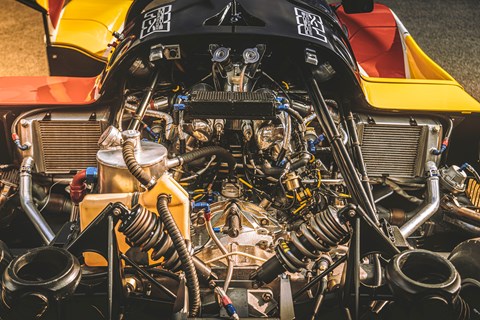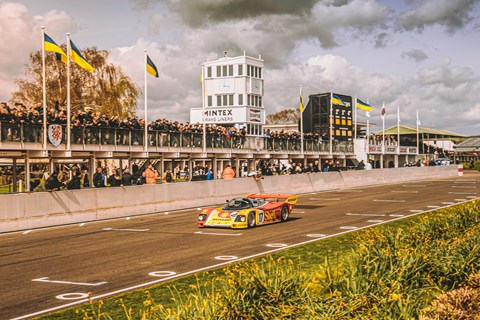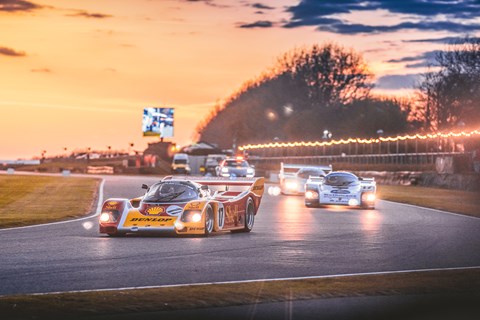► Driving the legendary Porsche 962
► A Group C hero tested at Goodwood
► Read and watch our drive review
It starts with a key. All that technology, downforce, power, a decade’s worth of endurance racing dominance – you start it all with a stubby plastic-topped key in the dashboard. Twist it long enough for the six-cylinder engine to catch and settle into a flat, buzzy idle. Push the weighty clutch pedal, carefully hook first gear (an aluminium lever, tucked away to the right): we’re away. Through the goldfish-bowl screen, the Goodwood circuit unfurls, bathed in orange under a setting sun. And upon it, a high-speed conga of Porsche 956 and 962 Le Mans cars, stretching as far as the eye can see. As 40th birthday parties go, this is a pretty special one.
There’s a good excuse for this shindig. In 1982, the formula for one of endurance racing’s most storied eras was introduced: the enigmatically named Group C. It was originally a set of technical regs designed to promote fuel efficiency but by the time the formula ended in 1993 it had created some of the most monstrous racing cars the world’s ever seen. Silk Cut Jaguars, screaming Mazda rotaries, home-crowd-hero Peugeots – but at the centre of it all (and invariably at the front of the grid), there was Porsche.

Stuttgart’s C specials won Le Mans six times in a row from 1982, with the 956 and the car it evolved into, the 962. To celebrate the Big Four-Oh, the 2022 Goodwood Members’ Meeting has mustered the biggest number of Porsche 956s and 962s in one place at one time since their heyday. Perhaps ever. There are 20 cars here and, somehow, CAR finds itself in their midst, at the wheel of a particularly special Porsche 962.
This 1987 car, chassis 009, has a unique history of its own. It didn’t race at Le Mans but instead won the Germany-based Group C Supercup championship, with legendarily successful driver Hans-Joachim Stuck at the wheel. Stuck counts the 962 as the favourite car he raced in his multi-decade career, and the most advanced: for this car also led a double life as a test bed for technology.
It was one of the first to be fitted with the now ubiquitous double-clutch PDK gearbox (although it’s since been converted back to manual), and ran with ABS and even rear-wheel steering at times
When its combat days ended, it was acquired by the Porsche Museum and until a couple of years ago it had lain dormant, in a plain white livery and a quiet corner. Today, it’s fresh from an 18-month restoration to its original spec. It really is like new, as if it’s been teleported straight from 1987 to the Goodwood paddock.

Furthermore, its engine actually is brand new. Its original flat-six sits safely on a shelf in Weissach but Porsche Engineering recently embarked on a project to provide customers with new, box-fresh 956/962 engines (there is such a market out there), and this car’s engine is the first validation version. (Fun fact: this engine family began life as an aborted Indycar project before being adapted for Porsche’s 936 Spyder Le Mans winner and thereafter slotted into the 956. Early cars were 2.65 litres; this car is running 3.0 litres.) And ‘about’ 720bhp. Eek
Stuck’s name is still proudly displayed on the car’s flanks as part of the arresting red/yellow Shell/Dunlop livery, the focus of countless swivelling smartphones at Goodwood (some of them belonging to racing royalty; Emanuele Pirro is one of many pausing to frame a picture of the Porsche on his iPhone in the paddock). Even among the blue/white Rothmans, pink Italiya and yellow/black New Man colours in this 13,000bhp+ carnival, it stands out like a lit flare. The livery was recreated manually by its original designer Rob Powell as part of the restoration, with stencils and tape.
I was born the same year as this car. Just a few years later it had finished racing, but I was lapping the lounge carpet with a Matchbox Porsche 956. Its ergonomic shape made the perfect toy car: I remember the shape of the domed cockpit and slab sides under my hands. And now, from inside the full-size thing, how does it feel? I’ll do my best to describe it.
You’re sat so far forward you feel almost as if you’re in fresh air, with a dramatic panoramic view ahead and to the sides through the domed screen. (The main difference between a 956 and 962 is an extended wheelbase to move the driver’s feet behind the front axle line, to pass regulations to race in America. You still feel as if you’re sat almost on top of the front wheels, however.) You wear the front of the car like a shield, your right arm beneath the outer bodywork as you change gear, the rest of the machine billowing behind you like a wingsuit.

The gearing is long. Gigantically long. This car is in ‘sprint’ specification, running shorter gear ratios (and shorter-in-length, taller-in-height rear bodywork than the Le Mans cars) – but first gear is still tall enough to be the gear of choice for Goodwood’s tighter corners, and you could do the whole lap in second should you wish. Tight corners are in short supply at Goodwood – it’s a fast place, fast enough for the 962’s ground-effect aerodynamics to come alive and its enormous venturi tunnels beneath the bodywork to squeeze the car into the track surface like my childhood hands on the Matchbox model. Through the relentlessly fast first half of the lap – Madgwick, Fordwater, St Mary’s – you trust the car implicitly. Its limits feel unscalable.
The need to cope with all that downforce pressing on the suspension means it’s very firm, and finds bumps I didn’t know existed at Goodwood. But it’s not scary; you feel so thoroughly in touch with the car through the steering. It’s unassisted and feels He-Man heavy in the pits but becomes lighter and alive, kart-like, once the car is at pace on track. I have a bit of a sweat on after 15 minutes; dread to think what a double stint at Le Mans must have felt like.
It’s fast, of course. Crushingly so. Despite the long gearing, the needle swings round the little offset tacho on fast-forward, in tandem with the jet-like whoosh of the turbos. Prime for a gearchange with your right hand on the lever – now – there’s an explosive flutter of wastegate chatter and the needle begins its merry-go-round run again. No wonder these things were knocking on the door of 250mph down pre-chicane Mulsanne.

It feels like that’s where we are now, the orange sky morphing to an inky blue and the 962’s headlights beginning to cast beams on the tarmac, while the rear lamps of the car ahead temporarily daub red graffiti across braking zones. The brakes are mighty, by the way; they need a firm press but they definitely get it stopped. Of course; they’re built to do that for 24 hours straight.
Impressionist colours, surround-sound turbocharger flutters, out-of-body glimpses of the car from the outside as we pass the circuit’s big screens. It’s like a fever dream.
In my mirrors – well, Stuck’s mirrors; I’m intensely aware I’m only temporarily this car’s driver – there’s the Rothmans colours of the 1987 Le Mans-winning 962. Further ahead, there are drivers who raced these cars in period, including F1 star John Watson. We’ve all been told to drive sensibly, albeit at a decent lick of pace; neither Goodwood nor Porsche want the cars to be driven too slowly.
It’s an overawing experience and I’d be lying if I said I wasn’t nervous. But the 962 looks after me the way it’s looked after drivers since its creation. The gearbox has synchromesh, the better to avoid a race-ruining mis-shift at 3am in the rain. So even if my shifts aren’t quite as laser-perfect as a Derek Bell’s, a Jacky Ickx’s or an HJ Stuck’s, each change slots cleanly and smoothly. The handling is predictable, the stability unshakeable, at these demo speeds at least. There’s turbo lag but it’s not the nothing… nothing… BAM! nightmare I’d feared of an engine running around 240bhp per litre; it’s progressive, manageable. And potent.

So potent yet usable and reliable were the 956 and 962 that even if the Porsche factory team didn’t cross the line first, its cars still won Le Mans in the hands of independent teams. So potent, in fact, that even after the Group C era had ended in 1994, a Dauer 962 ‘road car’ slipped through a loophole to enter Le Mans – and won the race. And the 962’s engine and gearbox would win the race again in ’96 and ’97, attached to a TWR prototype.
From behind the wheel, that extraordinary turn-key ease of use runs through everything the 962 does. The hardest part of driving it is trickling back into the paddock. It does not like to be driven slowly. The near-solid spool differential (for reliability, again) means the rear wheels can’t rotate at different speeds, and it nearly grinds to a halt on full lock. Clearly the 962’s heart yearns for the Mulsanne.
It’s lifting the hearts of everyone around it, too. Seeing people’s reactions to the car from within it is almost as powerful a sensation as driving it. The 962 and the Group C era might be long gone, but it’s still captivating for those who were there and those seeing it come alive for the first time. That little plastic key can fire one engine, and countless imaginations.